A Beginner’s Guide to Sauerkraut (+ Fermented Vegetables)
Today, I’m talking cabbage. (Stay with me…it gets better, I promise!) Now cabbage and I, we have a bit of a love-hate relationship. I like cabbage, but it arrives in the veg box every week, reminding me that there’s still last week’s cabbage in the fridge refusing to go bad.
(Of course, I can’t put a perfectly good cabbage in the compost. If it happened to accidentally go bad…well, maybe I could justify it, but cabbage is stubborn!)
In fact, cabbage simply refuses to go bad, which actually makes it a rather good zero waste vegetable. (It shrivels a little and the outer leaves go brown, but peel those leaves back and there’s still perfectly good cabbage underneath.) Plus it grows at a time of year when many other more delicious vegetables do not.
If you want to eat seasonal and you live anywhere except the tropics, cabbage is going to feature on your menu. But cabbage week in, week out; it can wear a bit thin.
That, my friends, is why we need to embrace sauerkraut.
Sauerkraut is fermented cabbage. That might not sound delicious, but it’s a tangy, crunchy, super healthy vegetable that’s tastier than the name suggests. Sauerkraut contains millions of good bacteria, so is like taking probiotics, but without the packaging. Sauerkraut also lasts for ages in the fridge.
I’ve kept sauerkraut in the fridge for a year. Fresh cabbage might seem to last forever, but it won’t last a year.
The good news is, whilst fermenting sounds hard, it is actually very easy. Plus you don’t actually need any specialised equipment. Sure, there’s all kinds of fancy gadgets out there, but you can get going with a glass jar and a tea towel. Oh, and some cabbage ;)
That said, you don’t actually have to make sauerkraut with only cabbage. You can mix cabbage with other vegetables like onion, carrot and beetroot.
But let’s not get distracted thinking about all the wonderful potential! Let’s start at the beginning.
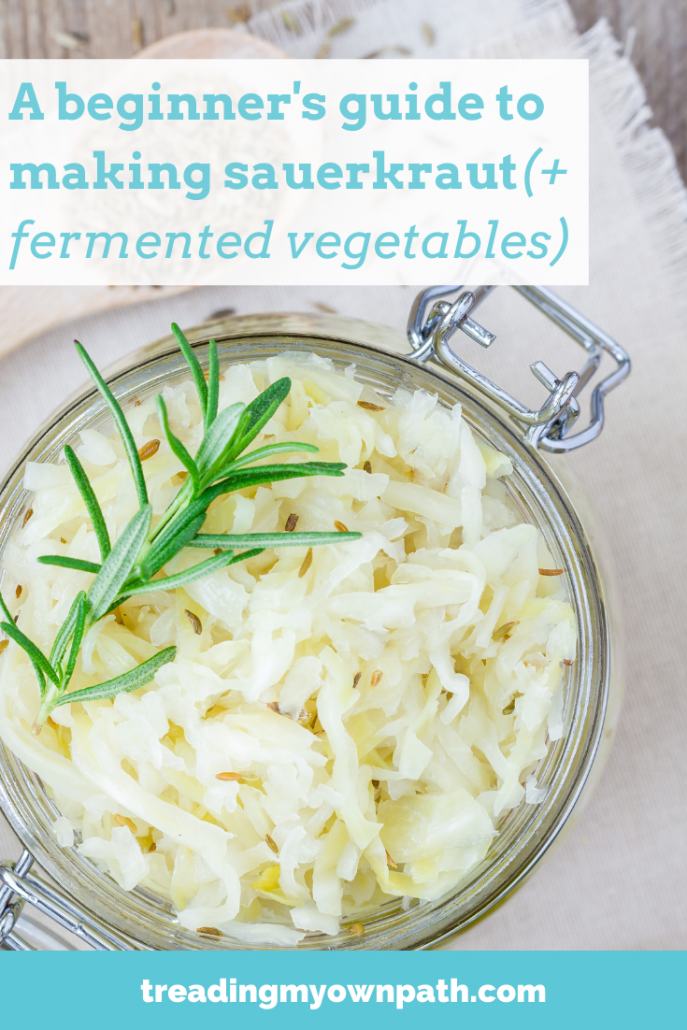
Some Fermentation Basics
Fermentation is a process that uses good bacteria and yeast to transform a product. By fermenting, we crowd out the bad bacteria with good bacteria, which changes the flavour and texture, but also helps lengthen the shelf life of the product. For example, yoghurt is fermented milk: whereas fresh milk will last in the fridge for up to a week, yoghurt might last a month.
Fermenting is anaerobic, meaning without oxygen. (Although confusingly, some foods are actually fermented with oxygen, such as vinegar.) In my experience of making sauerkraut, this “without oxygen” rule doesn’t need to be absolute. By removing oxygen we create conditions for the good bacteria to multiply, and these prevent the bad bacteria getting a hold and spoiling the food.
Fermentation has been used for centuries as a way of preserving food, prior to refrigeration. People were fermenting long before air-lock attachments and special fermentation jars were invented. This specialist equipment can help, but isn’t necessary.
I make sauerkraut a few times a year, and I simply don’t see the need to buy specialised equipment when it works without.
Because we are dealing with bacteria, we need to be careful not to be too over-zealous with the cleaning. I’d avoid using an anti-bacterial hand wash or chopping boards, for example. Clean is good, sterile not so much.
How to Make Sauerkraut (No Fancy Equipment Required)
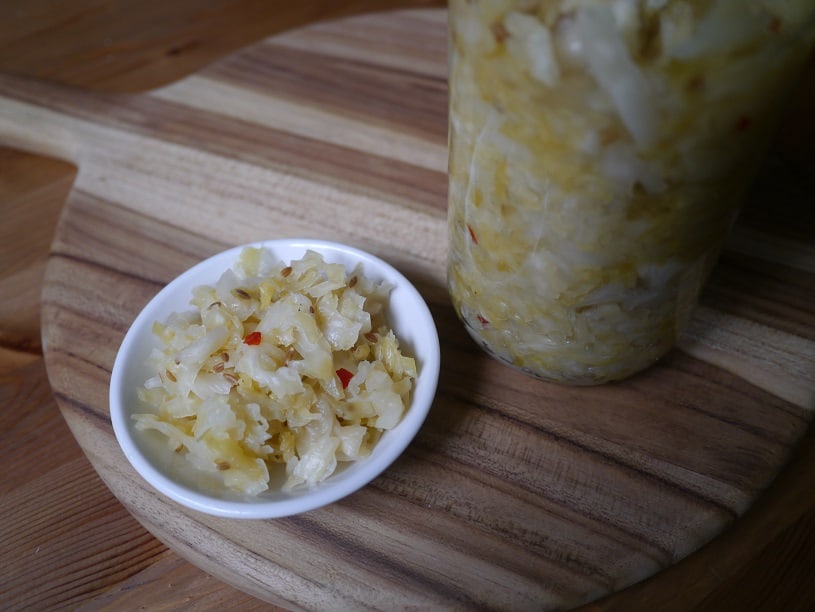
I’m a big believer that you don’t need fancy equipment. I don’t use any, and I’ve been making sauerkraut and other fermented vegetables for over 4 years. If you’re a professional, that’s different, and with certain ferments, it can be crucial. But for sauerkraut, I personally don’t believe that it is.
Ingredients:
Cabbage;
1/100th weight of cabbage in salt.
So if the cabbage weighs 1 kg, use 10g salt. Basically, divide the weight by 100. (It is possible to eyeball it, but when starting out it helps to measure.)
Equipment:
A large bowl;
A glass jar that you can fit your fist into (or if you have large hands or small jars, you’ll also need a wooden rolling pin);
A weight that fits inside the glass jar (I use a smaller glass jar filled with water);
A tea towel.
Method:
I’ve included a lot of photos before to give you a really clear idea of what each stage is meant to look like.
Remove the core of the cabbage (the stalky white bit), and chop the cabbage into strips. Weigh the cabbage, put into a large bowl and sprinkle the salt on top (the amount is calculated based on the weight of the cabbage – 1 kg cabbage equals 10g salt).
Massage the salt into the cabbage with your hands, and the salt will begin to draw the water out of the cabbage. This is what you want to happen. Massage for 10 – 15 minutes until the cabbage looks like it has shrunk.
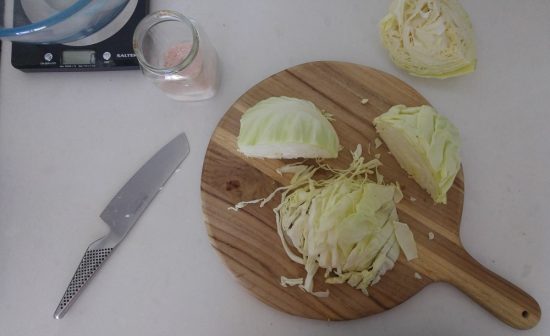
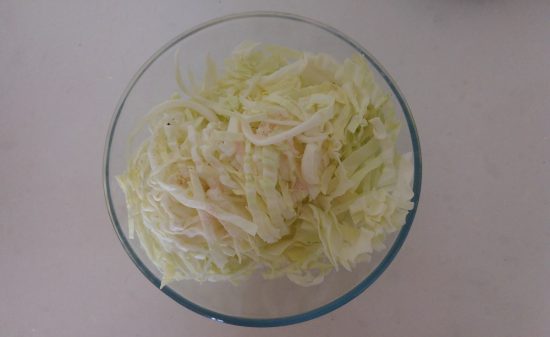
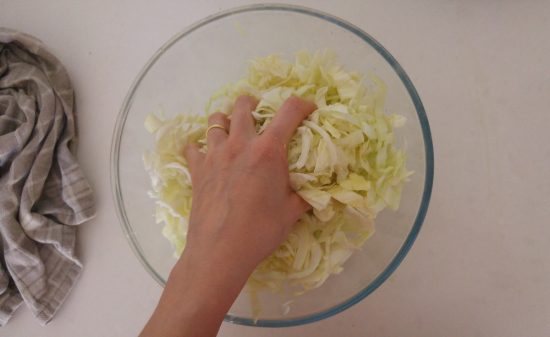
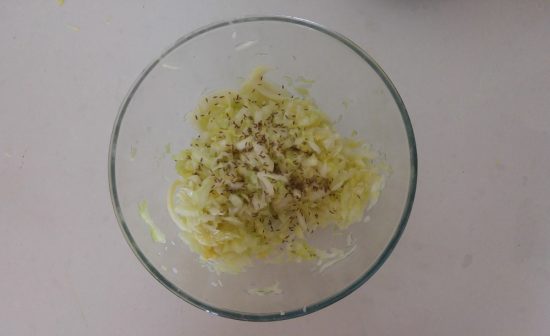
At this stage I always add a tablespoon of cumin seeds. I love the flavour it gives. You can keep yours plain, add cumin or go crazy with the spices. At the beginning, I’d suggest keeping it plain until you learn what flavours you’re meant to be looking out for.
Notice how the cabbage appears to have shrunk. (If you taste it at this point, it will taste like salty cabbage, not sauerkraut.)
Next you need to start packing the cabbage into the jar. Choose a jar that’s going to have room for the juices to expand because they will. Ideally find one that you can fit your hands into, but if not, a rolling pin will work.
Put a few tablespoons of cabbage into the jar, and press down as hard as you can. You want to squeeze out any remaining liquid. Keep adding the cabbage and pressing, and you’ll start to see the liquid rising above the cabbage.
This is important as the liquid helps keep the oxygen away from the cabbage, and creates the right conditions for fermentation.
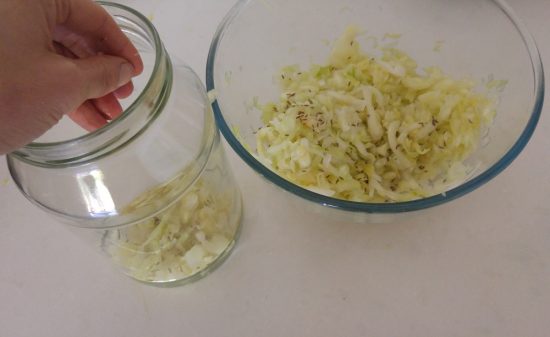

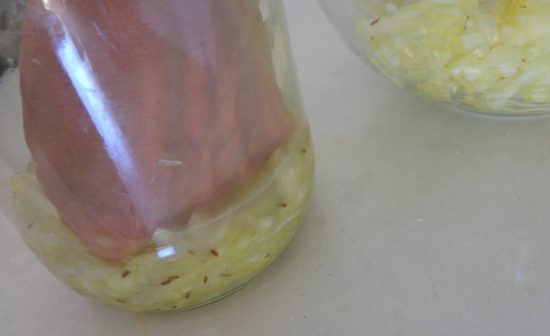
Once you’ve put all the cabbage in the jar, add any liquid remaining in the bowl into the jar. Do not add any other liquid.
The cabbage will probably sitting slightly under the water level. To compact it down and thereby raise the liquid level, use a weight. I use a smaller jar that fits inside my large jar, or a bottle (I fill it with water to make it heavier).
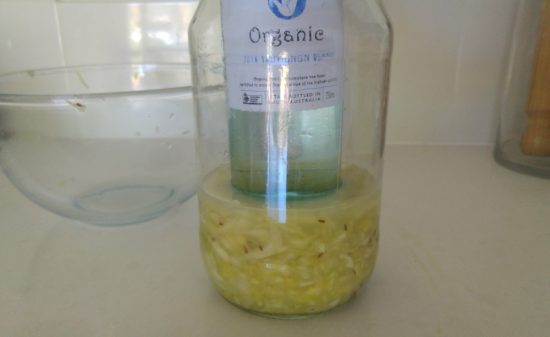
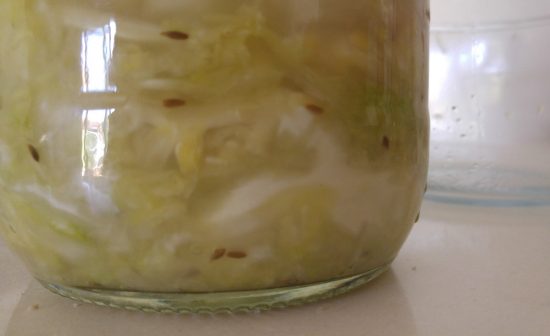
If there’s any floating or escaped bits of cabbage, poke them under the liquid. Next, I cover with a tea towel.
The bottle on top is pressing the cabbage below the water line and excluding oxygen, and the bottle restricts the amount of jar entering through the lid. For me, this is enough.
If you’d like to put a lid on the jar (and it fits), this will exclude oxygen better. However, it has its own drawbacks. In the fermentation process, carbon dioxide gas will be released. Unless you remember to open the lid at intervals to allow the gas to escape (called “burping” the jar), your jar could explode. Won’t happen with a tea towel!
(That’s why you can buy fermentation valves that allow carbon dioxide to escape without letting in oxygen. For some things, like cider making, it is very important. For sauerkraut and lactic acid fermentation, it is less critical.)
Every day, check your cabbage. You’ll start to notice bubbles forming. I tend to press the weight down to squeeze out the bubbles, and also check for any floating bits. If there’s cabbage floating on the surface, it is in contact with air (oxygen), so needs to be submerged or removed.
After 1 day (see the bubbles starting to form both on top, and within the cabbage layers):
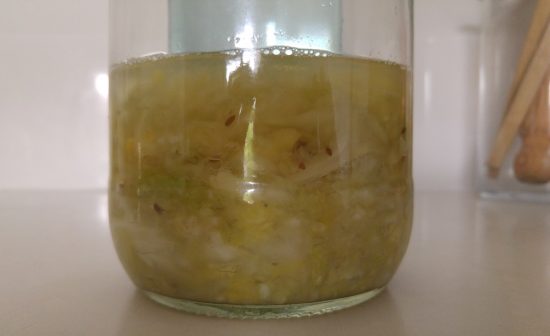
And after 3 days: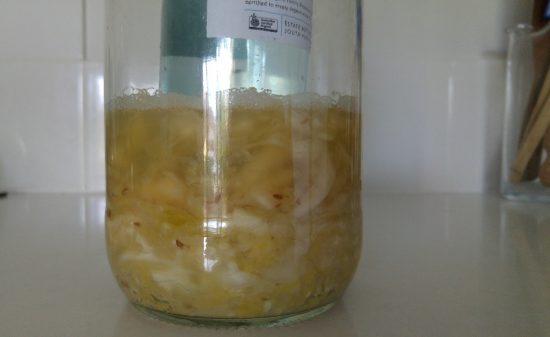
How quickly and how much it bubbles will depend a lot on room temperature. If your jar is narrow or filled to the top it can be helpful to place in a bowl as it might bubble over!
This is a different batch, but shows how much it can bubble (and I’ve seen more than this!):
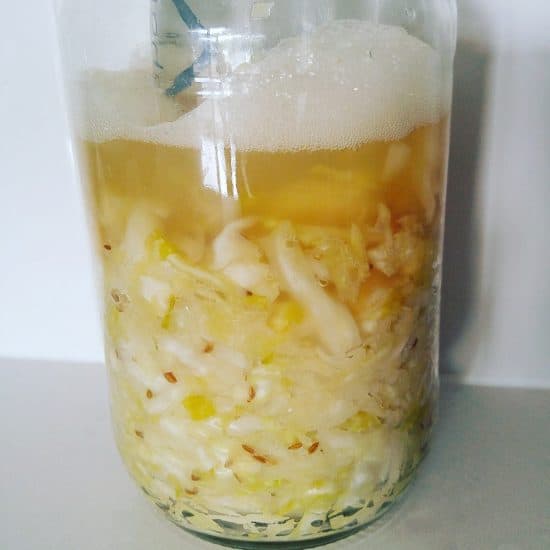
I tend to keep my sauerkraut on the kitchen counter, covered with a tea towel (to also exclude light) until the bubbling subsides, which takes 1 – 2 weeks.
Some people like to leave their sauerkraut on the counter for several weeks or even months to increase the good bacteria (it will also taste more sour). In my view, it doesn’t really matter, and once in the fridge fermentation won’t stop, it will just continue very very slowly.
When the bubbling subsides, the sauerkraut should be crunchy and taste sour (but delicious). You may see a white film, this is kahm yeast and is harmless. I’ve never had an issue with mold, but if you see anything multi-coloured or blue, that batch might be better in the compost.
When you’re ready to place in the fridge, you can remove the cabbage/sauerkraut from big jar and put into something more practical. The less surface area the better, so choose a smaller jar. At this stage it is fine to place a lid on the jar.
Other Fermentation Ideas
You can ferment most veggies and even fruits, but they have varying levels of difficulty. If you’re a beginner, stick to hard veggies like beetroot and carrot, or use softer vegetables like onion as part of the vegetable mix, but not all of it.
That said, I’ve had success fermenting chillies, and I’m sure capsicums would work well also.
My personal favourites are carrot, onion and white cabbage with cumin seeds – taken from a South American ferment called curtido.
I also like beetroot and purple cabbage together because the colour is fantastic.
I made an amazing turmeric ginger sauerkraut once that tasted like piccalilli, but I’ve never been able to recreate the flavour combination since.
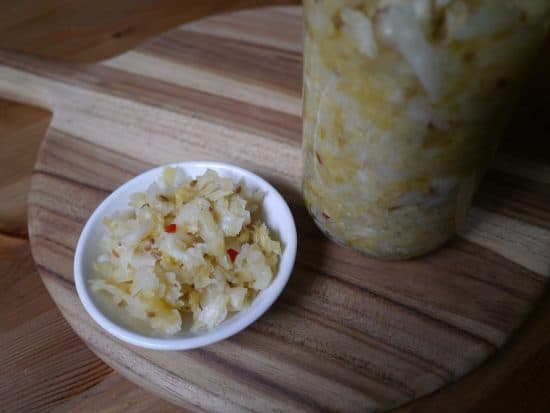
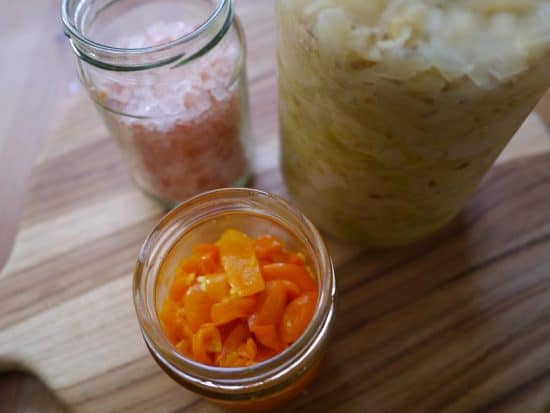
 Fermentation is a great way to preserve vegetables, and it a healthier option than pickling: the food is literally “alive” with good bacteria (there’s not heat process to kill them) and there’s no added sugar.
Fermentation is a great way to preserve vegetables, and it a healthier option than pickling: the food is literally “alive” with good bacteria (there’s not heat process to kill them) and there’s no added sugar.
Plus it means I get to keep my cabbage in the fridge for literally months, without feeling the slightest bit guilty about it!
Now I’d like to hear from you! Do you ferment vegetables? What are your favourite flavour combinations? Have you had any disasters? Are there any other tips you’d like to add? Are you tempted to give this a go, or does the idea still scare you a little? Please tell all in the comments below!
[leadpages_leadbox leadbox_id=123a865e9839c5] [/leadpages_leadbox]
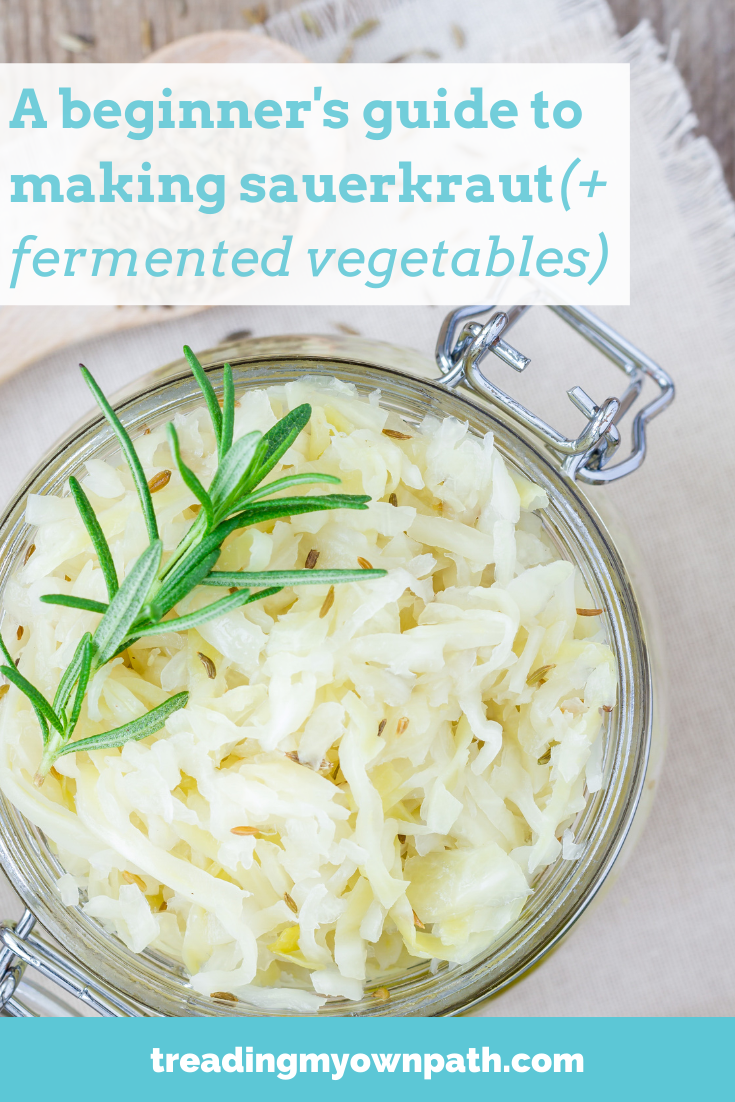

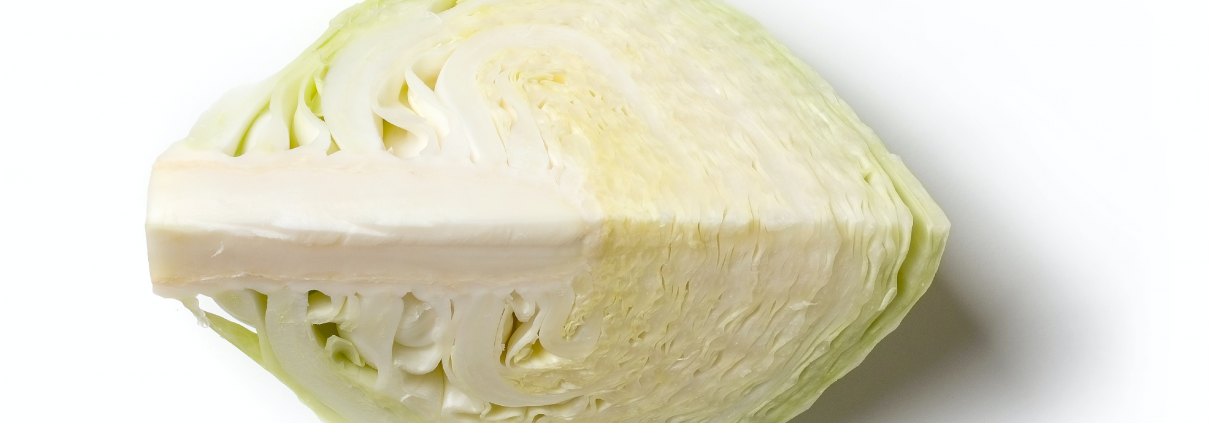



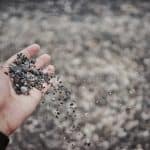

Thank you for this – I may finally work up the courage to try fermenting veggies!
May I ask what type of salt you use (ordinary table salt, sea salt, etc.)?
Arghh, I meant to write about salt! Thanks for the reminder Danielle.I used rock salt as that is what I have. Natural sea salt or rock salt should be fine. You don’t want to use table salt with iodine added, as iodine is anti-microbial and will kill all the good bacteria! By any natural, nothing added salt is good.
My husband has been making sauerkraut and cucumber dill pickles for ages now. We also have a glass of milk kefir every day. Not everyone’s cup of tea but I love it plus it has loads more different types of probiotics than most other ferments. Eleanor
I was planning to make fermented cucumbers last summer, but my cucumber harvest was abysmal. This year I will plant plenty more. I remember trying milk kefir – I could not get over the fact it fizzed when I opened it! We bought a litre bottle, and I thought it was gross, but I wasn’t going to throw it away. And funnily enough, by the end of the bottle I had grown to quite like it!
I make sauerkraut for the first ever time about 2 weeks ago, yet to try. I did not massage I just poured the salty water over the finished product. I over filled the jar, once it started to ferment, it went EVERYWHERE and yes I used red cabbage and beetroot :( I need to start reading instructions :)
Oh, you learn about the overfilling jar issue very early on! And unless you love cleaning, it is not a mistake you make twice! I sometimes stand the jar in a bowl if I think it is close. Because I use a tea towel, of course the tea towel absorbs all the juice and makes the room smell of cabbage too.
Good luck with your next attempt!
We never really buy cabbage, but this week I got given a cabbage by my parents who are overseas (it was in gladwrap! eek!) so now I have no excuse but to try this! I’ve been meaning to do more fermenting (I’ve made ACV but that’s it) for ages. Have you ever made Kimchi Lindsay?
Fortuitous timing, Sarah! I’ve never made kimchi but my understanding is that it’s a Korean version of sauerkraut (i.e. the same type of fermentation). The other difference is that it contains fish sauce, although of course there are vegetarian/vegan versions. Unlike you I ALWAYS seem to have cabbage, the sauerkraut kind not Chinese cabbage, so I’ve never tried. It is on the to-do list, but so are a lot of things!
We often have Chinese cabbage since I find it easier to get without plastic (and I like it more). I’ve finally started by sauerkraut today, hopefully it’s successful. Thanks for the recipe!
Thanks for this Lindsay, the step by step instructions and pictures along the way are really helpful. I’m inspired and will buy a cabbage today.
My pleasure Vanessa. I want to say “good luck” but honestly, you don’t need luck. But do let me know how you get on!
Yes! Sauerkraut was my gateway into fermentation, now fermenting anything I can get my hands on! Amazing what vegies, salt, millions of microbes and time can create! Agree on the cumin seeds. In my last batch I added fresh dill which was also a winner! Cheers, Sally
Hi Sally, I’m with you – sauerkraut is a gateway! I’ve never tried fermenting fruit, at least, not yet. I want to try mead next! ;) So many options, so little time…
Perfect timing! I’ve been thinking for a while now about getting into fermentation but was worried about the whole bacteria growing thing and the whole me not studying science ever thing! The process seems far less ominous now.
I love cabbage in all its manifestations, so I’m keen to make sauerkraut. Your instructions are very clear so I now feel confident to begin.
My only hesitation is the salt! I retain water quite badly if I have too much salt. Are these proportions essential?
Hi Caroline, yes the salt is necessary in these proportions to create the right conditions for the lactic acid bacteria. But the resulting cabbage isn’t that salty, and the salt draws out moisture from the cabbage that creates a brine, so you can drain your sauerkraut to reduce the salt. Hope that helps!
This looks like a great recipe! Thank you for sharing, definitely want to try this one at home the next time I tackle a sauerkraut project! I’ll report back with how it turns out!
Thanks for this easy recipe. I have made 3 jars of kimchi using a Jamie Oliver recipe but although they tasted nice they did not ferment. Having read your comment about salt I see why as I used table salt so yesterday I did another 2 jars , one kimchi and one sauerkraut. using natural sea salt. There are no signs of fermentation at all and I wonder if it is because my kitchen is fairly cold?
Hi Rosemary! If your kitchen is cold it will take longer to get things going. The other thing could be not using organic or spray-free vegetables. You’re relying on natural yeasts to begin the fermentation process, and if these aren’t there because of heavy spraying that might be an issue. If you have any live ferments (as opposed to long-life ones that have been pasteurised) you could add a little of the brine to kick-start it. Hope that helps!
Ha, in my decluttering I found my old glass marbles from my youth.
They’ll make an ideal weight for the jar.
Ooooh good idea, Davie!
I have never tried sauerkraut but your post came up as I was trying to make use of an amazing veg box I had delivered. Your instructions and pics were easy to follow. I look forward to trying it in a couple of weeks.
Let me know how you get on, Beth!
So excited to have started my sauerkraut today – it’s my first ever attempt and I’m so nervous about it getting mouldy and needing to be thrown away. We recently had a total failure at attempting sourdough so hopefully this goes better! :)
Sourdough is definitely much trickier – or at least, many more factors to consider and things to go wrong! Hoping it works :)
Lindsay, when the mixture is transferred to the fridge is it still necessary for the cabbage to be below the brine…do you remove the ‘weight’? AND does your bottle ‘weight’ have its lid on when fermenting on the bench?
Thanks in anticipation :)
Good question! I only keep the weight on for the first few days, until it’s bubbling and smells sour. It’s just to keep everything submerged until the fermenting bacteria do their thing. I don’t use a lid when it’s on the bench with the weight as the lid wouldn’t fit, so I just drape a tea towel over. You need air to get in, so if you do put a lid on, keep it slightly ajar – or you might get an explosion!
I can’t get the fermentation process going! Twice I’ve tried and nothing happening! After 2 weeks no bubbles and cabbage smells eggy. Shall I start again. I notice yours has more liquid . If I press down on the cabbage the liquid covers the cabbage. Thank you
If you’re buying cabbage from the store, it’s possible it’s been cleaned with chemicals to remove the natural bacteria. You could add a splash of apple cider vinegar to get it going. Make sure you massage the cabbage well, you want to break down the cell walls to release the liquid.
My sauerkraut is a rotten mess. Mold and stink! I guess I didn’t add enough salt…or I added iodized salt. Not sure, as I didn’t weigh it, I just followed a recipe that said 2 teaspoons and I had 2 full heads of cabbage. Oh well – at least I only wasted a couple cabbages! I’ll try again.
Hi Heather, oh no! The salt could be a reason, yes. Two teaspoons to two full heads of cabbage doesn’t sound quite right to me – but then again, heads of cabbage can be all different sizes! The other thing might be that the cabbage has been heavily sprayed. I try to use organic, homegrown or spray-free. Otherwise brine from an existing live ferment can get it going…
i normally only ferment hot sauce, but have fermented cabbage as part of a job i had previously. i must have forgotten how i was doing it because i made it WAY too salty, over packed it to the point of not being able to get rid of any floaters (it molded a little on top) I also forgot to massage the cabbage and did just a straight cabbage/salt/punch-it-down scenario… so this was helpful as i aim to do it again. all in all my sauerkraut turned out fine, i just had to rinse it a bit to get rid of the saltiness and it maybe could have softened up a bit more but i was struggling with the top mold. nothing more than a few white spots which i just scraped out everything was fine after, but a pain nonetheless.
Fermented hot sauce is on MY to-do list, Devin! White mold isn’t always bad (unlike green/blue mold), but without seeing it I can’t comment – and it is better to be safe than sorry with these things!
I’ve never tried sauerkraut but interested to try it. Would a repurposed large coffee plunger work to keep the cabbage below the liquid do you think?
Ooooh I think this would work very well, Kerry! Do give it a go, and then report back!
Would fermenting with only a tea towel over top create an odor in the house? This is a memory my husband had of his father doing this when he was young……
Probably depends on how well ventilated your house is, Wendy… it does have a sour odour. Ther are plenty of things I find smell worse. Maybe give it a go and see what you think?!
i followed a different recipe that said to just push down the cabbage everyday. Had a lid on it, but it grew each day to become uncovered from liquid quite a bit. It’s been three days and only now i’ve switched to using a jar of water to keep it weighted down and a tea towel over top to release the gasses. The recipe said to taste it each day but now I feel off-put. I tried it on day two (yesterday), and it tasted a bit gross. It tasted like the gas smells. i figure I’ll give it till the bubbles subside and try it again. No mold. Maybe yeast is growing? I don’t know. I feel like scraping it and starting over. Thoughts?
I’ve never bothered tasting each day, I just watch the gas begin, build up and then tail off when it’s done. I’d be waiting at least a week before I tried to eat it! Hmm, I would probsbly keep going with it. It’s pretty forgiving, I’m sure it will turn out fine. Unless you see scary coloured mold, I think it’s okay :)
Hi there. I’m very late to the party, but I’m curious as to what needs to be done after transferring to a smaller jar. Do you add the liquid as well or leave it in the fridge with no liquid? TIA
Hi. Are you responding to messages here? I have a question about sauerkraut. I’ve been making it on and off for about 50 years. Just now we have a 2 gallon crock on the kitchen table – for about a month – averaging around 70 degrees – full gallon jar on top for a weight – a sort of moderate salt content – always covered with brine – no sign yet of mold or discoloration – doesn’t taste overly salty, or particularly pickled. It just seems like it is on hold, indefinitely. I don’t get it. Every other batch, year, time – it has definitely gone through it’s stages and come out great. So, why won’t it progress?
Danielle, this was a very good discussion on sauerkraut. I have a question. When I see the foam, do I remove it? Or is it ok to leave it on top of the brine?
I love fermented pickles. Love them so much, I started a garden 12 days ago and am growing Boston pickling cucumbers. And, after reading and seeing your sauerkraut, I will have to make this too. Thanks